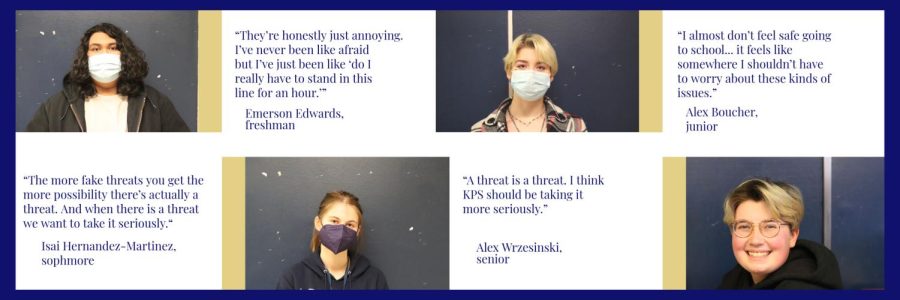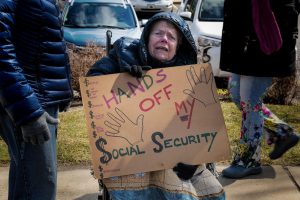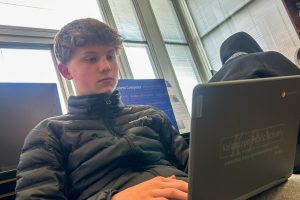School communities suffer without a solution to the increase in gun violence and threats
Credit: Sophie Grover
Graphic containing photos of students along with their thoughts and feelings on the threats of violence that have occurred during the 2021-2022 school year.
February 24, 2022
 Editor’s note: This story is part of “State of Mind: The Modern Condition of Youth,” produced in partnership with local, independent news outlet NowKalamazoo, which provided editorial support and guidance.
Editor’s note: This story is part of “State of Mind: The Modern Condition of Youth,” produced in partnership with local, independent news outlet NowKalamazoo, which provided editorial support and guidance.
Loud talking and giggling swarm the halls as groups of students make their way to class. Heat swells in the air and the lights burn against sleepy eyes. It’s early in the morning and the sun isn’t up yet, but Loy Norrix is bustling with life. School is a place to learn and make friends.
In 2021, a year in which many schools were online for a portion of the year, gun violence killed 49 and injured 126. In 2019, a year before the COVID-19 pandemic started, there were 33 deaths and 78 injuries because of gun violence on school grounds. This statistic hit extra hard in November when 4 students of Oxford High School, a place only a few hours away, were killed and 7 were injured by a peer with a gun.
This is the last place you want to hear a gunshot.
“You come back to this place where you miss it way more than you thought you would… and now you’re back and people think it’s funny to threaten your community,” said senior Faye Thomas.
This year, Norrix had three threats by the time winter break hit.
“You’ve always had school shootings be a reality but also, we went through our own threats and that was scary, and that was followed by Oxford, and I think that brought a lot of fears to life more intensely,” said psychology, sociology and women’s studies teacher Rebecca Layton.
When school shootings and threats happen, the media tends to primarily cover the perpetrator. However, students and teachers have expressed that the focus should be on the mental health of survivors and others affected.
Knight Life hosted an open discussion with Lewis Ezekiel, Norrix social studies teacher, and his current event classes on gun control and students’ feelings about threats to the school and the recent Oxford shooting.
“We shouldn’t be raised to expect this. And now that we are, I’m not sure how to deal with it. It’s scary to me and I’m not afraid to admit that,” said Thomas.
During the discussion, many of the same overarching feelings were expressed: fear and anger.
Dr. Jean Kim, Medical Officer at the federal Food and Drug administration said, “Mass shootings are a first-line traumatic event that can potentially trigger post-traumatic stress disorder in people who are directly exposed,” according to Psycom, a consumer mental health resource website.
Children are more vulnerable to things like PTSD because “multiple studies have shown that childhood trauma has more lifelong and pervasive effects on young, developing psyches,” Kim writes. Even the threat of a mass shooting is harmful to mental health because it’s a threat to safety and security which are “always paramount to a child’s healthy psychological development.”

“If there’s anything that schools or communities could do to help prevent that [school shootings] is just to be more aware of those kinds of signs,” said junior Eden Holm-Griffis..
The Sandy Hook Promise, an organization started after the deaths of many young people in a mass school shooting, published a list of signs you can look out for in a potential school shooter: withdrawing, bullying, excessive irritability, chronic loneliness/social isolation, thoughts of harming self or others, making threats, bragging about access to weapons, recruiting an accomplice and having a plan and expressing it.
When Norrix was threatened on September 23, metal detectors were put into place as a safety precaution on September 24 and 27 and there was extra security on campus. On Nov. 16, there were metal detectors due to a social media threat the night before, and then there was a threat during school hours, causing extra security and dogs to come in during fifth period.
According to pro gun control research organization, Every Town Research, an average of 52 American children and teens are killed or injured by a gun everyday. Prevention of gun violence has been a widely talked about issue, especially since Stoneman Douglas High School students started the March For Our Lives movement in March of 2018.
“I feel like everytime a school shooting happens, the country is upset about it, like embarrassed and stuff like that, but nothing really changes. What have we done since the Oxford shooting to change gun violence in school? Nothing,” said Norrix junior Kate Flanagan.
In a 2019 Pew Research survey, it was found that both Republican and Democratic leaning people pretty much agree on enforcing and creating more background checks on private gun sales and are somewhat in favor of not letting mentally ill people have access to guns. The disagreement is over what type of guns people should be able to own.
“There’s a difference between a hunting rifle and an AR [automatic rifle],” said Flanagan.
Gun violence is preventable. Solutions range from cracking down on gun access, a difficult step in a country that is very passionate about its access to weapons, and addressing a mental health crisis, which could be the root of the issue.
After a mass-shooting in Australia, the country pushed through the National Firearms Agreement, prohibiting automatic and semi-automatic firearms and requiring licenses and genuine reasons to own a gun. Australia seldom has mass shootings: the last talked about shooting in Australia was in 2019, where only 4 people died.
“In the long term, it’s a lot more effective to fix the root issue. Instead of getting to that point [someone walking into the school with a gun] why don’t we just do things to support mental health,” said freshman Emerson Edwards, a member of Ezekiel’s third period.
“How many more people need to die or lose family before politicians actually start taking steps to reduce the occurrence of that [gun violence],” Edwards.












